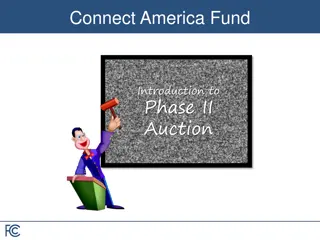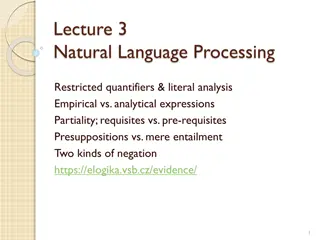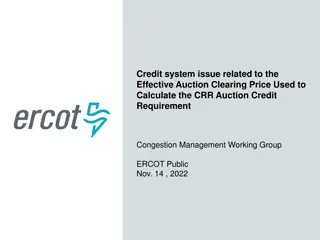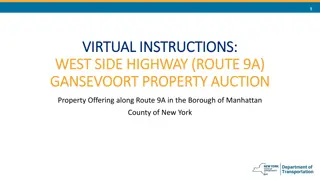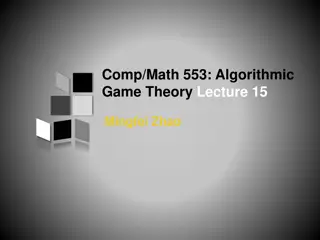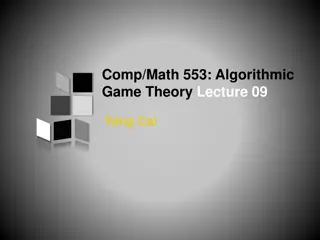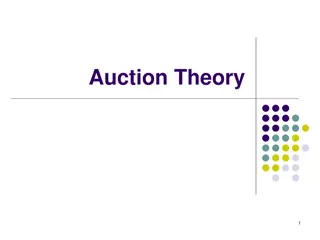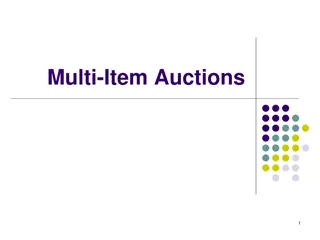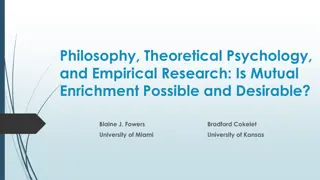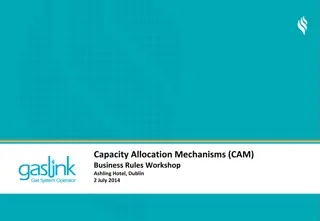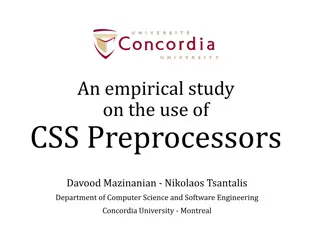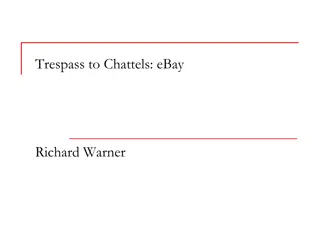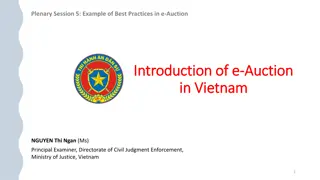Understanding Auction Design: Empirical Analysis and Practical Insights
Auctions play a crucial role in various sectors due to their efficiency in price discovery and resource allocation. This article delves into auction design issues, the role of structural analysis, and the transformative Laffont program. Discover the importance of empirical analysis in optimizing auction mechanisms and enhancing policy-making.
Download Presentation

Please find below an Image/Link to download the presentation.
The content on the website is provided AS IS for your information and personal use only. It may not be sold, licensed, or shared on other websites without obtaining consent from the author. Download presentation by click this link. If you encounter any issues during the download, it is possible that the publisher has removed the file from their server.
E N D
Presentation Transcript
Empirical Analysis and Auction Design Ken Hendricks University of Wisconsin Robert Porter Northwestern University ESWC Montreal August 17, 2015
Inspired by Jean-Jacques Laffont, 1947-2004 Econometric Society President 1992 ES WC 2015 2
Introduction Auctions are a widely used trading mechanism for both procurement and sales, in both the private and public sectors. Why use an auction, instead of posting or negotiating a price? 1. Price discovery: Buyers willingness to pay is private information. Relevant when the item is unique, or market conditions are changing. Past sales of similar items may not be reliable indicators of current market conditions. Auctions reveal bidders willingness to pay before the price is set. 2. Efficient allocation: Identity of highest value buyer is unknown. Relevant when seller does not know the best use of the product. An auction lets the market decide how to allocate resources. Imperfect and asymmetric information is central issue for optimal design. ES WC 2015 3
Auction Design Issues What are the objectives of the seller? What are the characteristics of the item being sold? Product design Contractual terms governing ex post investments and use Who can bid? Eligibility requirements Investments in information acquisition and other entry costs What are the auction rules? Open outcry vs. sealed bid Reserve price; public or secret Differential treatment of bidders Entry fees or subsidies ES WC 2015 4
The Role of Structural Analysis In some instances, seller can run field experiments to address design issues. E.g., online seller with many trading opportunities can experiment with auction rules and design. Einav, Levin et al (AEJ: Micro 2015) compare identical goods sold on eBay by the same seller at approximately the same time. Assess the impact of different reserve prices on sale probability and the sale price. Elfenbein, Fisman & McManus (AEJ: Micro 2015) conduct a similar analysis of an eBay seller certification program. However, experimentation to explore the set of possible rules and design parameters is not practical in many cases. In these cases, structural analysis can play an important role. Economic theory guides the interpretation of data. ES WC 2015 5
The Laffont Program Transform mechanism design from a theory about unobservables into a theory that is testable, implementable, and useful for policy-makers. For convenience, consider a seller s auction. Normative question: What is the optimal selling mechanism, from the perspective of the seller? Revenue maximizing, efficient, or some other criteria. The answer depends on features of the economic environment, and hence empirical analysis can play an important role in auction design. Here focus on structural analysis to recover primitives, such as the joint distribution of buyers valuations and their information, from bids. Positive analysis that sheds light on the preferences and behavior of the bidders also plays an important role. E.g., is bidding consistent with some Bayesian Nash equilibrium? Are bidders colluding? ES WC 2015 6
Outline Goal: describe current state and challenges of the Laffont program with applications 1. Auctions Design under Revenue Equivalence single item, symmetric and risk neutral bidders, Independent Private Values, Bayesian Nash equilibria 2. Auction Design: More general information environments when Revenue Equivalence doesn t hold 3. Contract design and Entry 4. Applications: Oil & Gas and Timber Auctions 5. Conclusion ES WC 2015 7
1. Auction Rules: Basic Model n number of (potential) bidders m number of bids ( active bidders) Xi private signal of bidder i X = (X1, , Xn) V common payoff component Ui = u(Xi,V) bidder i incremental payoff if obtain one unit F joint distribution function of (X,V) Yi = max{Xj, j i} W winning bid i(x) bidder i s (monotone) bid strategy i(b) inverse bid function of bidder i ES WC 2015 8
Main Assumptions Each bidder wants only one unit. Utility function u is non-negative, continuous, and increasing in each argument, and common across bidders. Bidders are risk neutral. F(X,V) is symmetric in the signals X (exchangeability). (X,V) are affiliated. Xi is real-valued. F, n and u are common knowledge. The losing bidders don t care who wins. We will relax several of these assumptions later. ES WC 2015 9
Special Cases Private Values (PV): The important restriction here is: E[u(Xi,V)| X] = E[u(Xi,V)| Xi] Can normalize the signal Xi to be an unbiased estimator of valuation: Xi = E[u(Xi,V)| Xi] Independent PV (IPV): Xi s iid with marginal distribution function Fx Affiliated PV (APV): Xi s are affiliated. If not PV, then Common Values (CV). Also known as interdependent values. Pure Common Value: u(Xi,V) = V, scalar V u(Xi,V) = Xi ES WC 2015 10
Revenue Equivalence Suppose bidders are risk neutral and symmetric, with IPV distributed according to d.f. FX(x), p.d.f. fX(x) Then the symmetric Bayesian Nash equilibria under first and second price auction formats yield equal expected revenues, given a reserve price r. Empirical analysis of bidding data inform the reserve price choice. If the seller s valuation is x0, the efficient reserve price is x0 The expected revenue maximizing reserve price r satisfies r = x0 + [1 - FX(r)] / fX(r) This is the optimal take-it-or leave-it offer to a random bidder; doesn t depend on number of bidders. To implement, need to estimate FX. Can use the techniques of Guerre, Perrigne & Vuong (GPV, Ema 2000) to estimate FX. ES WC 2015 11
GPV for FPSB IPV Expected profits from bidding b, given a signal x and rivals strategy (.): (b,x) = (x b) Pr{win | bid b} = (x b) FX( (b))n-1 Differentiating with respect to b and imposing symmetry (b = (x)): (n-1)[x (x)] fX(x) = (x) FX(x) if x r; r = (r) Laffont & Vuong (AER 1996) idea: Let G denote the d.f. of a random rival bid, and g its p.d.f. Then FX(x) = G( (x)) and fX(x) = g( (x)) (x). Substitute into the FOC and evaluate at b = (x) to obtain inverse bid function: (b) = b + G(b)/[(n-1)g(b)] = (b,G) for b r (b,G) must be monotone increasing in b, with lim (b,G) = r as b r. Unobserved bidder type x is obtained from his best reply to empirical distribution of rivals bids. ES WC 2015 12
Estimation Method Suppose all bids are observable. Estimation proceeds in two steps. 1. Estimate G and g (parametric or non-parametric). Form valuation estimates: xit = (bit , G) This yields a sample of pseudo-values. 2. Use the pseudo-values {xit} to estimate F. If variation in n is exogenous, can pool across sub-samples with different n. Advantages of the first-order approach: Need not compute equilibrium Need not rely on functional form assumptions Easy to implement computationally Can condition distributions on observable item characteristics ES WC 2015 13
English Auctions Haile & Tamer (JPE 2003) study oral, ascending auctions under IPV. Likelihood function is not well-defined due to multiple equilibria problem. There is no simple interpretation of losing bids. Suppose bi is i s highest submitted bid. Assume: A1. No bidder submits a bid greater than their value: xi bi for all i. A2. Losing bidders are not willing to raise the winning bid by the minimum bid increment : xi w + for all i except the winning bidder. The two assumptions provide upper and lower bounds on FX, without otherwise specifying equilibrium play. Surprisingly, the bounds can be quite tight. The implied bounds on revenues under alternative reserve prices are also tight. Caution: A2 may not be satisfied for equilibria with jump bidding. ES WC 2015 14
2. Extensions GPV framework can be adapted to many other settings: Asymmetric bidders: IPV with d.f. Fi Affiliated private values (APV) Unobserved heterogeneity Common values (CV) Risk averse bidders Asymmetric equilibria Multiple units Departures from BNE; e.g., collusion In the above settings, revenue equivalence no longer holds; optimal auction design entails more than choosing the reserve price. ES WC 2015 15
Asymmetric Bidders GPV is straightforward to adapt in case of FPSB with private values. Define Fi as the d.f. of bidder i s valuation. Bidder i s inverse bid function is a best response to empirical distribution of its highest rival bid, denoted M(i), with d.f. GM(i) and p.d.f gM(i). i(b) = b + (GM(i)(b)/gM(i)(b)) for b r Here GM(i)(b) = j i Gj(b) = j i Fj( j(b)), the probability that bidder i wins with bid b. Require sufficient individual bidder data to estimate the distribution function of bids, Gi(b). Or categorize bidders by observable types, consider type-symmetric BNE. Given estimates of Fi, characterize optimal mechanism (Myerson 1981). Typically, treat bidders asymmetrically. ES WC 2015 16
Auction Heterogeneity: FPSB If distribution of independent private valuations depends on observable auction characteristics, Z, can estimate FX(x|Z) by GPV methods. The inverse bid function is now: (b, Z) = b + G(b|Z)/[(n-1)g(b|Z)] for b r Optimal reserve price depends on Z. If auction characteristics are not observed by the econometrician then bids are correlated and, typically, inferred bidder markups will be too large. Empirical distribution of rival bids is the mixture of G(b|Z) over the distribution of Z. Solution, when heterogeneity is multiplicative: Non-parametric: Krasnokutskaya (RES 2011) When observe at least two bids, exploit bid ratios. Parametric: Athey, Levin & Seira (QJE 2011), Krasnokutskaya & Seim (AER 2010) ES WC 2015 17
Affiliated Private Values: FPSB Suppose instead correlation arises because valuations are affiliated. Laffont & Vuong: Fix n and let M = (Y) denote the highest rival bid among n rivals. Let GM|Bdenote the distribution function of M, conditional on one s own bid B, and gM|B the conditional p.d.f. Then FY|X(y|x) = GM|B( (y)| (x)) and fY|X(y|x) = gM|B( (y)| (x)) (y). Substitute into the FOC and evaluate at b = (x) to obtain the inverse bid function: (b) = b + [GM|B(b|b)/gM|B(b|b)] for b r For each value of n, use GPV methods to estimate the joint distribution of valuations. ES WC 2015 18
GPV for Symmetric FPSB under CV Expected profits from bidding b, given a signal x: (b,x) = (b) [w(x,y) - b] dFY|X(y|x) where w(x,y) = E[u(X,V)| X=x, Y=y] = x if PV. Differentiating with respect to b and imposing symmetry: [w(x,x) (x)] fY|X(x|x) = (x)FY|X(x|x) if x x*(r,n) Applying the Laffont-Vuong transformation of variables FY|X(y|x) = GM|B( (y)| (x)) and fY|X(y|x) = gM|B( (y)| (x)) (y), substituting into the FOC, and evaluating at b = (x) yields the inverse bid function: w( (b), (b)) = b + [GM|B(b|b)/gM|B(b|b)] = (b,G) for b r Here limb r (b,G) > r. ES WC 2015 19
Common Values The distinction between PV and CV is important in mechanism design. Laffont & Vuong (AER 1996): Any CV model is indistinguishable from an APV model, for a fixed number of bidders. Many studies estimate PV model, or choose PV vs. CV based on prior. But APV and CV models can be distinguished if there is exogenous variation in the number of bidders (Haile, Hong & Shum, 2006). Or if the reserve price is binding (Hendricks, Pinkse & Porter, RES 2003; Hill & Shneyerov, J Ecm 2013). CV model is also identified if observe measure of ex post value (HPP). Or if observe factors that affect bidder value asymmetries (Somaini, 2015) example: distance to job for highway repair contracts Even absent identification, can predict revenues from change in auction format from FPSB to SPSB (Sheneyerov, RJE 2006) or bound revenues from change in reserve price (Tang, RJE 2011). ES WC 2015 20
Affiliated Private Values: English Auctions Suppose the winning bid in an English auction is the second highest valuation, so W = Xn-1:n This assumption is stronger than Haile & Tamer s A2. Aradillas-Lopez, Gandhi & Quint (Ema 2013): In order to compute counterfactual revenues or bidder surplus under different reserve prices, it is sufficient to know the marginal distribution function of the second highest valuation (the winning bid), Fn-1:n, and the d.f. of the highest valuation, Fn:n The former is observed, the latter can be bounded. E.g., upper bound: Fn-1:n = Fn:n when valuations are perfectly correlated. Then can derive bounds on the optimal reserve price. ES WC 2015 21
Risk Averse Bidders Suppose bidders are risk averse. If symmetric IPV, FPSB yields higher revenues than SPSB. Suppose CRRA utility: u(x) = x where 0 < 1. Then FPSB inverse bid function: (b) = b + G(b)/[(n-1)g(b)] for b r Lower FPSB markups than under risk neutrality. In Vickrey auction (SPSB), (x) = x remains a dominant strategy. Hence risk neutral seller prefers Vickrey auction. Identification of risk preferences from FPSB data can be difficult (Campo, Guerre, Perrigne & Vuong, RES 2011): u(x) not identified non- parametrically, CRRA or CARA parameters are identified. Estimation is straightforward if payoffs are observed. E.g., Bajari & Hortacsu (JPE 2005) study experimental data. ES WC 2015 22
Asymmetric Equilibria Asymmetric equilibria? The SPSB CV auction with 2 bidders has a continuum of asymmetric equilibria (Milgrom, Ema 1981). E.g., if one bidder is aggressive, the other is relatively passive. If there are multiple equilibria, then must either assume equilibrium selection as part of estimation, or take multiplicity into account, say via bounds (as in Haile & Tamer). Sometimes concern expressed that merger might eliminate maverick. In auction context, maverick might play aggressive strategy when there are multiple equilibria. A merger may affect both the number of bidders and which equilibrium is played. Not much work on this to date. ES WC 2015 23
Multiple Units In many instances, multiple units are sold or procured simultaneously, rather than sequentially. Examples: treasury bills, wholesale electricity, spectrum licenses. Mechanism design choice for identical items: Discriminatory auctions, in which winning bidders pay their own bids, vs. Uniform price auctions, in which winning bidders all pay the same price (such as the lowest winning bid, or the highest losing bid). Ausubel & Cramton (2002) show that there is no clear ranking of the two designs according to expected seller revenues. The revenue maximizing choice is an empirical issue. Structural methods estimate the distribution of valuations, and so draw inferences about the consequences of changes in the selling procedure. Buyers may value more than one of the multiple units being sold. For non-identical items, there is also an issue of whether and how to bundle items, or allow package bids, to reflect complementarities. ES WC 2015 24
Treasury Bill Auctions Hortacsu & McAdams (JPE 2010) study discriminatory Turkish auctions. Model based on Wilson s (QJE 1979) analysis of share auctions, in which bid schedules are continuous. Assume private values, real valued signals. (Euler-LaGrange) necessary condition to demand q units at bid price b: vi(q,x) = b + Gi(b,q)/( Gi(b,q)/ b) where vi(q,x) is the marginal value at q given signal x, and Gi(b,q) is the probability that the bid b is accepted. Here vi(q,x) is smooth, decreasing in q and increasing in x. Analogous to the inverse bid equation in the single item case. Kastl (RES 2011) studies uniform price Czech auctions. Explicit recognition of bids as step functions, not continuous. Bidders choose the number of bid points, and (b,q) for each point. ES WC 2015 25
Multiple Units: Estimation Inverse bid equation for discriminatory auctions given signal x: vi(q,x) = b + Gi(b,q)/( Gi(b,q)/ b). where Gi(b,q) is the probability that the bid point (b,q) is accepted. Question is how to estimate Gi(b,q). Hortacsu & McAdams propose resampling method: For each bidder i, randomly draw with replacement from the set of rival bid functions n-1 times. If bidders are asymmetric, draw from sets of types to maintain number of rivals of each type. Sum bid functions to obtain estimate of aggregate rival demand function. Given aggregate supply and i s bid function, obtain estimate of market clearing price p, and hence whether b p. Repeat, to estimate frequency of b p, and hence Gi(b,q) for each (b,q) on i s bid function. Require large number of bidders, or pooling across auctions. ES WC 2015 26
Bayes Nash Equilibrium? BNE requires considerable sophistication. Alternatives might entail less sophisticated bidding (e.g., simple rules of thumb, such as linear or proportional bidding strategies) or systematic biases (e.g., winner s curse in common value auctions). Hendricks & Porter (AER 1988): pre-1980 oil & gas drainage auctions Bidding consistent with BNE of pure CV auction in which neighbors are better informed and collude, non-neighbors are uninformed (also Hendricks, Porter & Wilson, Ema 1994). Hendricks, Pinkse & Porter (RES 2003): pre-1980 wildcat auctions Bidding consistent with BNE of symmetric pure CV auction Another alternative is collusion. ES WC 2015 27
Collusion: Detection Auctions can be an effective price discovery process. But sellers are at an information disadvantage, and may be vulnerable to price manipulation by a buyer cartel. There will be a welfare loss from collusion relative to the non-cooperative outcome if potential gains from trade are foregone. E.g., if average bid prices are low, and potential sellers opt out of market; or if the auction outcome is inefficient. How to determine when collusion is present? To inform either antitrust policy or optimal auction design. Porter & Zona (JPE 1993, RJE 1999): reduced form tests, showing how behavior of subset of bidders deviated from BNE. Kawai & Nakabayashi (2015): suspicious patterns of bids across re- auctioned projects, focusing on rank reversals. Aradillas-Lopez, Haile, Hendricks & Porter (2015): test of affiliation of participation and bid decisions in oil & gas auctions by owners of neighbor leases. ES WC 2015 28
Collusion: Auction Design Suppose identify a subset of bidders who are colluding in a PV setting. Can estimate the value distribution of the representative bidder for the cartel, and that of the non-cartel bidders, assuming they compete according to BNE. Use GPV methods for asymmetric bidders. Then can derive the optimal reserve price. Caveat: This takes cartel membership, and the value distribution of the cartel bidder, as given. Under efficient collusion, cartel value is maximum conspirator value. But if cartel allocation of bidding privileges depends on auction rules, e.g. if conspirators are asymmetric, the cartel value distribution changes. Example: Asker s (AER 2010) structural analysis of behavior in stamps auction and preceding cartel knockout auction by bidding ring. Under CV, similar logic, complicated by cartel information aggregation. If mechanism design affects cartel information acquisition, also alters the degree of winner s curse faced by non-cartel bidders. ES WC 2015 29
Corruption Some auction designs can be vulnerable to collusion between a bidder (or a set of bidders) and the seller s representative. In a FPSB, a bidder might bribe the seller s agent to learn their rivals bids, to minimize payments when they win. Auctions with discretionary scoring rules are especially vulnerable. E.g., when bids have multiple dimensions (prices of multiple items, or price and quality); Burguet & Che (RAND 2004). Role for rules that limit the selling agent s discretion, or otherwise create an open process. Lewis-Faupel, Neggers, Olken & Pande (2014) provide evidence that adoption of e-procurement in India and Indonesia resulted in entry of non-local bidders and quality improvement, but not lower prices. Also concern about corruption of monitoring of contract implementation. ES WC 2015 30
3. Contract Design and Entry The scope and terms of spectrum licenses can be even more important than the auction rules for determining the allocation. Milgrom (2004), Putting Auction Theory to Work In many auction environments, the item being sold is a contract. e.g., spectrum license, oil and gas lease, timber lease, procurement. Contract design can affect the contractor s decisions and hence the value of contract. Obligation (timber) versus Option (oil and gas) Duration number of years Scope geographical coverage, tasks Terms royalty payments, incentive payments Restrictions preferred buyers ES WC 2015 31
Revenues vs. Efficiency The auction solves an adverse selection problem typically a tradeoff between efficiency and revenue (e.g., optimal reserve price exceeds seller s valuation). Contract design can help solve a moral hazard or economies of scope problem, enhancing the value of the contract. Seller s efficiency and revenue maximizing motives are often aligned. caveat: design could lower revenues through its impact on competition Empirical analysis can inform contract design choices. Bajari and Lewis (QJE 2011, RES 2014): measure the effect of penalties and deadlines on work rates and bids on highway contracts. Bajari, Tedalis, and Houghton (AER, 2014): study how renegotiation over work changes can affect costs and bids on highway contracts. Hendricks and Porter (AER, 1996): examine the impact of information spillovers and deadlines on the decision of whether or when to drill. ES WC 2015 32
Ex Ante Investments Bidders often have to invest resources to learn about the value of the contract or asset being sold. e.g., timber cruises, seismic studies, due diligence in M&A. The set of bidders, their valuations or their information may not be fixed. If auction design extracts all bidder rents, no incentive to invest. Theoretical Literature on auctions and information acquisition: Matthews (1984), Hausch & Li (ET 1993), Persico (Ema 2000), Bergemann & Valimaki (Ema 2002), Bulow & Klemperer (AER 2009) Persico: stronger incentive to acquire information in FPSB Seller pays investment costs indirectly via lower participation and bids. Simultaneous entry and bid is typically not optimal. Restricting entry can be both revenue and efficiency enhancing. The tradeoffs across entry/auction formats are largely an empirical issue. ES WC 2015 33
Two Models of Entry Value Learning Model: Bidders have no private information about their values prior to entry and pay a cost to learn them. Entry is random with respect to values. Bulow & Klemperer (AER, 2009): sequential bidding process is more efficient than auction but the latter usually generates more revenue. Value Updating Model (Ye (GEB, 2007): Bidders have a private signal about their values and pay a cost to learn more about them. Sellers will want to screen buyers to ensure higher value buyers enter. Lu & Ye (2014): two-stage mechanism where bidders bid for rights to enter a second-price auction with bidder-specific handicaps is optimal. Hendricks and Quint (2015): sellers can use indicative bids to screen buyers and thin the field ; efficiency AND revenue higher than in simultaneous entry and bid. ES WC 2015 34
Value Learning Athey, Levin et al (QJE 2011, AEJ:M 2012): asymmetric IPV Use GPV to estimate distributions of values of loggers and mills in timber auctions. Use the estimates to calculate expected profits from entering and apply zero profit condition to identify entry costs (or entry cost thresholds). Sealed bid is less efficient than open auction but attract more weak bidders (loggers) and can generate higher revenues. Set-asides lower efficiency and revenue; subsidies for weak bidders can eliminate much of those losses while achieving allocation goals. Li & Zheng (RES 2009, JE 2012): estimates both entry models for timber and highway contracts using MCMC methods; finds that value learning model fits the data better than the value updating model. ES WC 2015 35
Value Updating Marmer, Shneyerov, & Xu (JE, 2013): propose non-parametric tests of the two models. Li & Gentry (Ema, 2013): provides conditions under which the joint distribution of signal and values is identified. Bhattacharya, Roberts & Sweeting (AER 2013, RJE 2014, IJIO 2015): estimate selective entry for timber and highway procurement. If bidders are asymmetric, selective entry dampens value of bid preference programs. Evaluates different entry/auction formats including entry auctions ES WC 2015 36
4. Applications Consider two resource rights auction applications: Offshore oil & gas lease auctions Timber auctions US government employs different selling mechanisms, and there are differences in contract terms for the lease holders. Question: Are these differences well grounded? ES WC 2015 37
Economic Environment: Oil & Gas Federal offshore lands are partitioned into tracts. Considerable uncertainty prior to drilling. Deposit size, drilling costs, future prices To a large extent, uncertainty is common value. Similar drilling costs and valuation of deposits Private information concerns deposit size, not future prices or costs. Little effect on downstream market: future prices exogenous. Spatial correlation of deposits and their characteristics. Drilling outcomes informative about neighboring tracts Costly information gathering. Ex ante: Collection and interpretation of seismic data Ex post: Exploratory drilling ES WC 2015 38
Uncertain Drilling Outcomes Wildcat leases: 1954-1982: 1983-2002: Drainage leases,1954-1982: If adjacent lease is productive, Pr{drill} = 0.95 Pr{hit|drill} = 0.62 If adjacent lease is not productive, Pr{drill} = 0.66 Pr{hit|drill} = 0.26 Consistent with information externalities from drilling. If adjacent tracts have multiple owners, non-cooperative drilling is inefficient (delay & wasteful duplication near end of lease term). Hendricks & Porter (AER 1996): evidence of non-cooperative drilling. Pr{drill} = 0.64 Pr{hit|drill} = 0.50 Pr{drill} = 0.27 Pr{hit|drill} = 0.45 ES WC 2015 39
Economic Environment: Timber Federal lands are partitioned into tracts. Uncertainty prior to harvesting: Timber volume and species composition, harvesting costs, future prices To some extent, payoff uncertainty may reflect common values. But harvesting costs and valuation of timber may differ Private information concerns own valuation, perhaps volume and species composition, not future prices. Little effect on downstream market: future prices exogenous. Spatial correlation of common value components less important. Costly information gathering. Cruises: ex ante assessment of tract volume and species composition ES WC 2015 40
Potential Competition Potential competition varies over time and location. Oil & gas: Early years dominated by large oil & gas companies. Fewer large firms after series of mergers. In shallow waters, entry by many smaller firms. Less entry in deep waters; remaining large firms dominate bidding. Barriers to entry in deep water: Capital requirements, expertise Timber: Mills: differentiated by distance to tract, efficiency, specialization Loggers: subcontract with mills; akin to a competitive fringe Concerns about collusion (Baldwin, Marshall & Richard, JPE 1997) ES WC 2015 41
Seller Objectives Similar objectives: 1. Facilitate exploration and development 2. Government revenue ( fair return ) 3. Protect environment These three objectives necessarily conflict to some degree Stringent environmental standards reduce firms profits, and hence government revenues and the amount of development Design changes that capture a larger share reduce the incentives to explore and develop. There may be a conflict between revenues and efficiency if there are potential market power concerns. E.g., maximize revenues by limiting ex post competition. In these two applications, monopolization less of a concern small share of relevant market supply. ES WC 2015 42
Lease Design The product for sale in both applications is a leasing contract. Design issues: Lease rights Lease size Lease tenure Lease payments Main theme: The lease should be designed to enhance efficiency in information acquisition and ex post development. More efficient development enhances lease value, hence bidder s willingness to pay and the incentives for ex ante information gathering, and hence seller revenues. In contrast to auction design, there is not necessarily a conflict between efficiency and seller revenues in lease design. ES WC 2015 43
Lease Rights OCS lease is an option contract. Lease confers the right, but not the obligation, to explore and develop. If exploratory drilling is successful, then the lease holder also has the right to develop and extract the oil & gas (as long as the lease is productive). Under option contracts, many leases are not drilled. In some cases, drill only if nearby tracts are productive or prices increase. Congress has expressed concern over low drill rates ( speculative buying, hoarding ), argued for stricter work requirements. But this argument ignores the value of the option not to drill. If lease holders were required to drill, the value of leases is lower. Lease holder must drill if receive bad news (dry holes on neighboring tracts, falling prices). Bid levels are then lower, and firms bid for fewer tracts, lowering development rates and auction revenues. Timber: Lease holder has the obligation to harvest. Less of an information externality, option not to cut is less valuable. Smaller impact from requiring lease holder to cut. ES WC 2015 44
Lease Size OCS lease pertains to a tract, approximately 9 square miles. Too small to internalize information externalities from exploratory drilling. If adjacent tracts have multiple owners, private information inhibits efficient exploration plans. One solution would be to define leases on bundles of tracts. Problems with bundling: Efficient combinations are not obvious ex ante Bidding may be less competitive, if capital requirements limit entry The latter concern played a role in lease size choice, and the decision to allow joint bids. Timber leases also pertain to tracts. Might be economies of scope with respect to packages of leases associated with road building, but government subsidizes road building costs. Main issue is whether tracts are of efficient size, in terms of economies of scale of harvesting. ES WC 2015 45
Lease Tenure OCS lease tenure depends on water depth: 5 years if < 400 meters, 8 years between 400 and 800, 10 years if > 800 meters Tenure is more than sufficient to drill wells. Many tracts are drilled in the first year of the lease. What is the optimal tenure? Shorter tenure makes it more difficult to explore adjacent tracts sequentially when there are information externalities. Longer tenure may lead to inefficient strategic delay. Symmetric BNE implies lease holders have highest valuations at sale date. But information arrives afterwards, and it may be efficient to transfer ownership. Resale market suffers from adverse selection, due to private information. Potential buyers then wait for lease to expire and the tract to be re-auctioned. Argues for limited lease terms, but not too short. Timber lease tenure is shorter, typically 1 to 5 years. Incentive to harvest when prices high; option value from waiting. Short lease term for expeditious development conflicts with revenue goals. ES WC 2015 46
Lease Payments: Oil & Gas OCS leaseholder makes three kinds of payments: Bonus bid, payable at time of sale Annual rental fees until lease expires or production begins Royalty payments; fixed fraction of revenues from production Bonuses depend on bidder s ex ante value, royalties on ex post value. Rentals were small until recently, now increase with age of lease. Problem: high rental rates reduce option value, hence auction revenues. Since introduction of AWL, majority of auction revenues have been from royalty payments. Royalty rate has been 1/6, 1/8 in deep water. 1995 DRRA exempted deep water tracts from royalties on initial production, in an attempt to encourage exploration. Recent increase in royalties on new leases. What is the optimal royalty payment? Is it positive? ES WC 2015 47
Royalty Payments Arguments for positive royalty: Shares risk if bidders are risk averse Reduces asymmetries in common value auctions, intensifies bidding (Riley, RES 1988) Rent extraction if too little competition in auction Original motivation: Encourage participation by financially constrained bidders But positive royalty distorts the investment incentives of leaseholders. Drilling decisions based on profits net of royalties; marginal tracts not drilled Leases abandoned too soon How important is this concern? DRRA provides some evidence. Royalty exemption: 17.5 MMBOE for water depth of 200-400 meters 52.5 MMBOE for water depth of 400-800 meters 87.5 MMBOE for water depth > 800 meters What is the evidence? ES WC 2015 48
Effect of Deepwater Royalty Relief Consider outcomes of sales in 2 years before DRRA, in comparison with 2 years following DRRA. DRRA clearly had a large impact: No. of Tracts Sold Average Winning Bid (1982$) Drilling Rate Hit Rate Water Depth Before After Before After Before After Before After 0 - 200 1012 1187 478,869 497,314 .31 .27 .60 .54 200-400 63 112 360,646 626,104 .27 .23 .53 .46 400-800 115 228 353,640 795,300 .17 .19 .55 .27 >800 262 1851 196,834 495,286 .13 .07 .34 .51 ES WC 2015 49
Profit Based Royalties Might specify royalty payments as fraction of profits, instead of revenues. If are costs measured correctly, no distortion of ex post investment. However, royalty payments based on profits affect bidding, and ex ante information acquisition incentives. Moreover, ex post distortions if lease holder has private information about its costs (e.g., Laffont & Tirole, MIT Press, 1993). ES WC 2015 50


